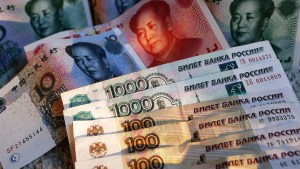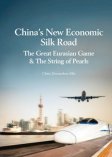China Isn’t Providing Central Asia with Cash Flow. So Who Will Manage the Eurasian Belt and Road?

 Remittances from China to Central Asia remain negligible according to research conducted by the Dezan Shira & Associates Belt & Road Desk. This is important because it defines the extent of Belt and Road Initiative as being purely a project financing issue and not a long term cash flow matter. That has implications for sustainable development and where the responsibility lies for keeping some of these still emerging economies viable.
Remittances from China to Central Asia remain negligible according to research conducted by the Dezan Shira & Associates Belt & Road Desk. This is important because it defines the extent of Belt and Road Initiative as being purely a project financing issue and not a long term cash flow matter. That has implications for sustainable development and where the responsibility lies for keeping some of these still emerging economies viable.
Russia continues to rule the region in terms of sending remittances to Central Asia. Most of these funds are sent to countries such as Uzbekistan, Tajikistan and Kyrgyzstan in the form of migrant workers in Russia sending money back home A report on this appears here on our Russia Briefing website.
Russia is a large country but with a population of just 144 million as against China’s 1.3 billion. This means that Central Asian migrant workers are a required commodity throughout Russia whereas they are not so in China. This imbalance also manifests itself in significant economic patterns – for example, some 30 percent of Kyrgyzstan’s total GDP comes from such sources, and over 90 percent of that is from Russia.
It is a similar pattern elsewhere. Remittances to Tajikistan from Russia have rebounded to hit about US$2.3 billion in 2017, whereas remittances to the country from China amounted to just US$1.6 million, mainly from Xinjiang Province.
The central banks of the Central Asian nations of Afghanistan, Kazakhstan, Kyrgyzstan, and Turkmenistan all report zero remittances from China, although it is acknowledged that the practice of hawala, or using agents, often relatives or close business associates, to transfer money and valuables, and the common practice of physically taking cash across borders, are prominent. This is why remittance flows are likely to underestimate the true amount being received by the region. (In Afghanistan, there are specific regulations permitting hawala payout services.)
In terms of Central Asian financial assistance then, it appears China has solely been concentrating on providing project finance. Yet, this has been rather more beneficial for Chinese contractors and laborers rather than helping sustain local economies. Chinese construction teams employ migrant Chinese workers, rarely locals, to build infrastructure; these wages are remitted back to China and do not remain in Central Asia. There are practical reasons for this. Many of these nations work forces are predominantly agriculture-based, and there are few qualified engineers, among other factors. Chinese labor fills that gap. But what it doesn’t do is provide sustainable cash flow. Someone still has to make the infrastructure work effectively and exploit its potential.
Once these projects are completed, and the Chinese go home, the responsibility for making the infrastructure work then rests with the pertinent national government and their respective corporate enterprises, be they state or privately owned. Many of these involve development and managerial, service oriented roles, and it is in universities and institutions in Russia that such expertise is now being sought. An emerging example here is Kazakhstan, which bucks the Russian remittance trend and is now sending about US$650 million to Russia to pay for Kazakh nationals studying there. As mentioned, there are also career opportunities in Russia that are unobtainable in China.
This movement of money, and the fundamental differences between cash flow remittances and project financing create a number of questions about China and Russia’s role in Eurasia. When a particular project is completed, what is the role of China? It is not a question that has yet been answered as part of the Belt and Road Initiative except a loose understanding that these countries will then have better access to China as a consumer market and vice versa. But clearly, as things stand, there will not be continuing financial support – other than maintenance contracts – for Belt and Road projects once the concrete has dried and the infrastructure is being used as a commodity.
For Russia, however, it is a different story. Moscow is strategically involved in both planning and later utilizing the Chinese infrastructure built throughout Central Asia. After all, much of the Belt and Road infrastructure doesn’t actually belong to China, it remains the property of the country it was built on, and one who paid for it.
After completion, a trend is emerging that is seeing the Russians, not the Chinese who are educating the Central Asians on how to use this new infrastructure, and in many cases, how best to exploit it. In fact, this is already happening, with programs at institutions such as the National Research University in Moscow already involved in educating MBA graduates and mature students in Belt and Road studies. This will ultimately benefit Russia, as the best will be encouraged to assist in Russia’s own infrastructure development program, and the returning graduates to Central Asia’s operating infrastructure that links both Russia and China using Central Asia as a hub. In doing so, Russia has effectively been able to get China to pay for a complete Central Asian upgrade, which it can then help exploit.
Cash flow is king, and the Russians understand that. They have achieved this by employing workers from Central Asia for decades and for whom Russia-sourced income is enough to support local economies in a way China has never managed to do. It also understands that by educating the Central Asian service managers of tomorrow, it can influence how the infrastructure can best be utilized to benefit Russia rather than China. That, in the longer term, appears a rather more sustainable economic model than China’s overseas ‘build and then hope for local Central Asian consumer market development’.
This challenges recent assumptions that Russia is losing traction to China in Central Asia. Although China is building the infrastructure, it doesn’t own it. The future direction and role Central Asia plays in Eurasian trade can be boiled down to a simple economic cash flow matter. It is Russia that has the need, and can provide the sustainability required. This raises serious questions concerning the sustainability of China’s role in Central Asia.
About Us
Silk Road Briefing is produced by Dezan Shira & Associates. The firm provides professional services to foreign investors and Governments on matters of Eurasian and Asian trade and investment, maintaining 28 offices throughout the region, including Beijing and Moscow. The practice maintains a China Belt & Road Advisory Desk. Please email silkroad@dezshira.com or visit us at www.dezshira.com
 Related Reading:
Related Reading:
![]() Central Asian Cashflow Remittances From Russia Increase As Belt & Road Is Restricted To A Project Based Source Of Funds
Central Asian Cashflow Remittances From Russia Increase As Belt & Road Is Restricted To A Project Based Source Of Funds
![]() How Foreign Businesses Can Prosper from China’s Belt and Road Initiative: Exploit the Infrastructure
How Foreign Businesses Can Prosper from China’s Belt and Road Initiative: Exploit the Infrastructure
China’s New Economic Silk Road
This unique and currently only available study into the proposed Silk Road Economic Belt examines the institutional, financial and infrastructure projects that are currently underway and in the planning stage across the entire region. Covering over 60 countries, this book explores the regional reforms, potential problems, opportunities and longer term impact that the Silk Road will have upon Asia, Africa, the Middle East, Europe and the United States.






